More ruggedized protective equipment. Reliable and interoperable communications. The capability to filter vast amounts of data. These are all things the Department of Homeland Security (DHS) Science and Technology Directorate (S&T) Next Generation First Responder (NGFR) program envisions to ensure future first responder are better protected, connected and fully aware. First responders who are better protected and have the right information at the right time will be safer while they execute their mission of protecting their community.
To achieve this vision, S&T’s NGFR program recently held a demonstration highlighting innovative technologies that combined to improve communications and situational awareness of first responders during disasters and critical incidents. The demonstration integrated physiological and environmental sensors, streaming video from body cameras and unmanned aerial systems (UAS), and hybrid communications devices during a simulated emergency scenario calling for a coordinated response from law enforcement, firefighters and emergency medical technicians.
“The proliferation of miniaturized sensors, affordable UAS and Internet of Things (IoT) devices can make a tremendous impact on first responder safety, connectivity, and situational awareness. However, if the technology doesn’t seamlessly share data, it loses its viability within the public safety sector,” said S&T’s NGFR Program Manager John Merrill.
The NGFR program focuses on creating an interoperable environment by outlining the standards required for seamless integration of technology. These standards allow responders to employ off-the-shelf commercial products, adapt ground-breaking technologies that meet responder mission needs, and visualize technologies yet to be invented – all with the assurance they will fit into the predefined NGFR architecture. Further, the modular and extensible design is intended to work for responder organizations in different environments, with different budgets, and contrasting mission requirements.
“To accommodate all responders, we are working to offer organizations a variety of interoperable, plug-and-play technologies that provide the capabilities they need for a price they can afford,” said Merrill.
This demonstration is the first in a series of NGFR integration demos to be held during the life of the program. Future demonstrations will integrate additional technologies as they mature, define and test how commercial capabilities can plug-and-play into the NGFR system, and invite the first responder community to test and evaluate the latest NGFR program technologies.
Responders interested in participation in future demonstration events or evaluating technology solutions should email the NGFR program at first.responder@hq.dhs.gov.
